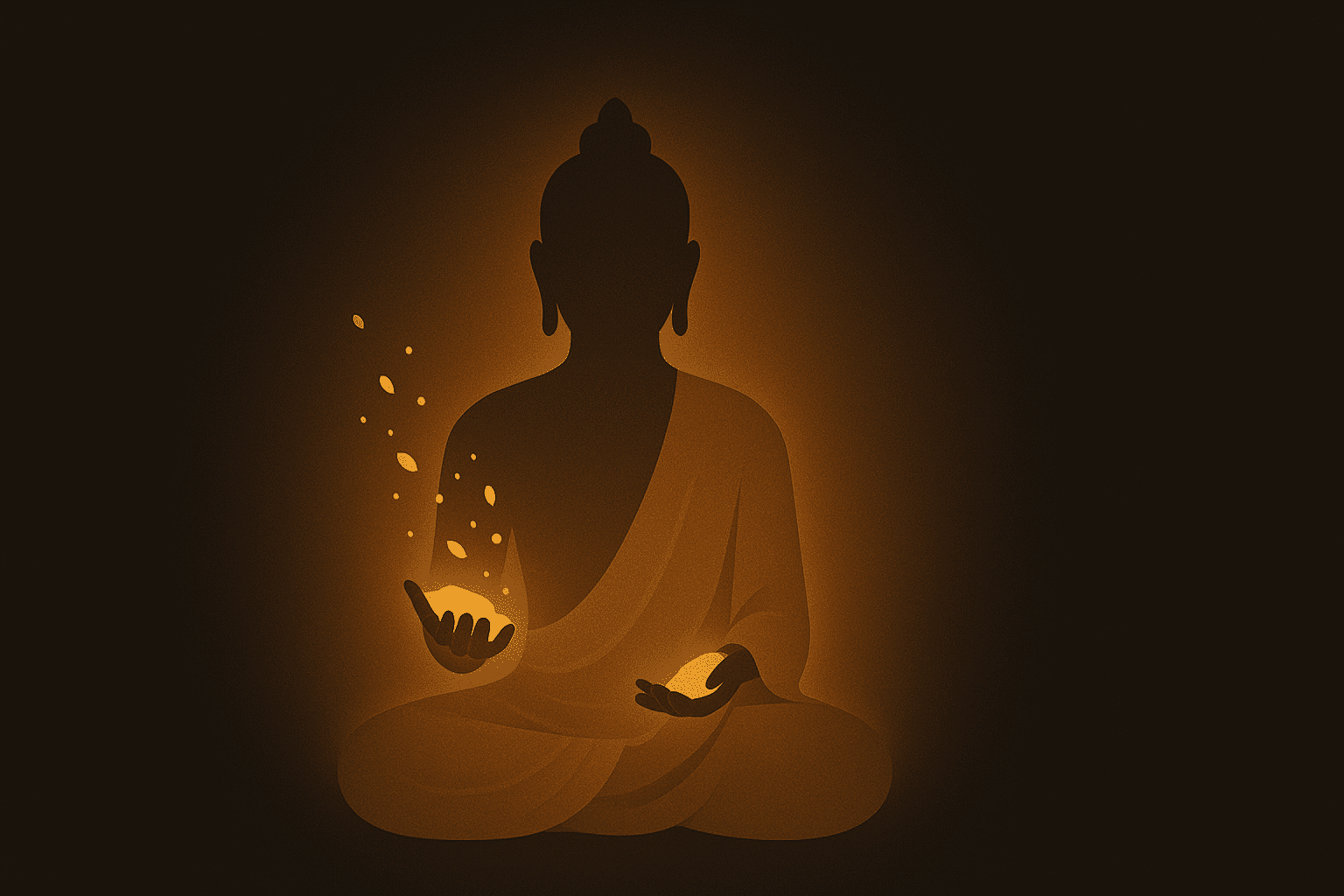
🌿 The Possibility of Peace
After seeing that life includes Dukkha (unease) and that its cause is craving (Samudaya), the Buddha revealed something truly hopeful — Dukkha can end.
This is the Third Noble Truth, called Nirodha, which means cessation, release, or freedom.
It is the discovery that when craving ends, peace naturally appears.
The Buddha didn’t promise heaven or miracles — he pointed to a simple truth we can test for ourselves:
“With the fading away of craving, there is the cessation of suffering.”
— The Buddha (SN 56.11)
💭 What Nirodha Really Means
Nirodha is not escape, suppression, or numbness.
It’s the quiet freedom that comes when the mind stops chasing and resisting.
When craving fades, even briefly, the mind feels open and light — free from the endless “I want,” “I must,” “I can’t lose this.”
You may have already touched Nirodha in small, ordinary moments:
- when you let go of an argument and suddenly feel calm,
- when you stop worrying about outcomes and simply rest,
- when you forgive someone and the weight inside dissolves.
That moment of inner release — that’s a glimpse of Nirodha.
🌍 Freedom in Modern Life
Nirodha is not reserved for monks or saints.
It’s available to anyone who learns to see and release craving, even in daily life.
Here’s what Nirodha can look like today:
- Freedom from Comparison: You no longer measure your worth by likes or followers — peace replaces insecurity.
- Freedom from Control: You stop trying to make everyone or everything perfect — and suddenly breathe easier.
- Freedom from Fear: You realize uncertainty is part of life, and it no longer feels threatening.
- Freedom from Attachment: You love, but without clinging; you care, but without chains.
- Freedom from Restlessness: You stop running from discomfort, and calm begins to grow naturally.
Nirodha is the stillness beneath the noise — already here, once we stop fighting life.
🪷 Nirodha Is Real, Not Ideal
The Buddha didn’t ask anyone to “believe” in peace — he asked us to see what happens when craving ends.
You can observe it directly: when you drop desire, stress drops too.
“When craving is gone, the heart becomes still — just as fire goes out when the fuel is gone.”
— The Buddha (SN 38.1)
This is not a mystical state; it’s a natural process of the mind returning to balance.
🔍 How to Experience Nirodha in Daily Life
You don’t need to go anywhere — you just need to watch how craving appears and fades.
Try this simple daily observation:
- Notice Desire: When you feel tense or restless, pause. What are you wanting or resisting right now?
- Breathe and Let Go: Don’t feed it — just let it be seen.
- Feel the Release: Notice how the body relaxes when you stop pushing.
- Stay Present: For a few seconds, enjoy that stillness — that’s peace without conditions.
- Reflect Kindly: Recognize — peace doesn’t have to be created; it appears when grasping ends.
Even small moments of letting go are moments of awakening.
🌼 Nirodha Is Not the End of Life — It’s the Start of Freedom
Some people think letting go means losing joy or motivation.
It’s the opposite. When craving ends, life becomes lighter, not duller.
You can enjoy what you have without fear of losing it.
You can act wisely without pressure to prove yourself.
You can love without attachment — care without anxiety.
Nirodha is not “nothingness.” It’s wholeness without clinging.
🌅 Closing Reflection — The Peace Beyond Wanting
The Third Noble Truth gives us hope — not by promising escape, but by showing that peace is already possible here and now.
Every time you let go — even a little — the mind remembers its natural state: calm, open, and kind.
Peace is not something you gain — it’s what remains when craving fades.
This is Nirodha: the stillness of freedom within the flow of everyday life.
🪷 Understanding Nirodha — Practical Q&A
1️⃣ What is Nirodha?
Nirodha means cessation or release — the end of Dukkha (suffering, stress, and inner struggle).
It’s the moment when craving (taṇhā) fades, and the mind rests in peace.
It’s not a reward or miracle — it’s the natural result of letting go.
2️⃣ Does Nirodha mean the end of desire or emotions?
No. Nirodha isn’t about becoming cold or empty.
It’s about freedom from being controlled by desires or emotions.
You still feel joy, sadness, or love — but they come and go freely, without tightening the heart.
When attachment ends, emotions still move — but they no longer bind.
3️⃣ Is Nirodha something only monks or spiritual masters can experience?
Not at all. The Buddha taught Nirodha as a human possibility, not a mystical state.
Everyday people can taste it in small moments — when you forgive, when you stop arguing, when you release a grudge, when you rest without chasing. Those calm moments are glimpses of Nirodha.
4️⃣ How does craving end?
Craving ends through understanding, not suppression. When you observe how wanting creates tension, and you stop feeding it, it fades naturally. Like fire dying out when fuel runs out — peace appears when craving has no support.
“When craving fades, peace arises naturally.” — The Buddha
5️⃣ What does Nirodha feel like in real life?
It feels like a quiet space inside — calm, open, and kind. You no longer need to win, prove, or control. There’s lightness, clarity, and a sense of “enough.” It’s the peace of not fighting yourself or the world.
6️⃣ How can I experience Nirodha in daily life?
You can begin right where you are: Notice when you’re tense or resisting something.
Pause and breathe instead of reacting. Let go of one small need for control. Watch how the mind relaxes when you stop chasing outcomes.
That small ease — that’s a taste of Nirodha.
7️⃣ Does Nirodha mean doing nothing?
No — it means doing things without clinging. You still work, love, create, and help others — but from peace, not pressure. You act wisely because you want to, not because you must. This is action without attachment — the most peaceful kind of effort.
8️⃣ How is Nirodha different from temporary happiness?
Temporary happiness depends on conditions — a new phone, praise, success, comfort.
Nirodha is unconditioned peace — it remains even when circumstances change.
It’s not excitement or pleasure; it’s a calm joy that doesn’t rely on “something else.”
9️⃣ Can anyone reach complete Nirodha?
Yes, gradually. Every moment of letting go brings a taste of freedom. As wisdom and mindfulness grow, craving weakens naturally. Even partial freedom — less anger, less anxiety, less clinging — is already Nirodha at work.
🔟 Why is understanding Nirodha important?
Because it gives hope — not blind hope, but real possibility. It shows that peace isn’t something you have to earn or pray for. It’s already within you, waiting to appear when craving falls silent.
Peace isn’t something added to life — it’s what remains when struggle ends.
